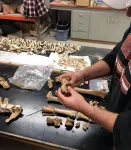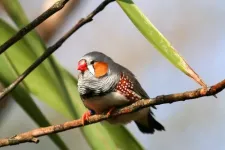(Press-News.org) A new analysis of a horse previously believed to be from the Ice Age shows that the animal actually died just a few hundred years ago--and was raised, ridden and cared for by Native peoples. The study sheds light on the early relationships between horses and their guardians in the Americas.
The findings, published today in the journal American Antiquity, are the latest in the saga of the "Lehi horse."
In 2018, a Utah couple was doing landscaping in their backyard near the city of Provo when they unearthed something surprising: an almost complete skeleton of a horse about the size of a Shetland pony. Scientists and the media took note. Preliminary data suggested that the horse might be more than 10,000 years old.
"It was found in the ground in these geologic deposits from the Pleistocene--the last Ice Age," said William Taylor, lead author of the new research and a curator of archaeology at the CU Museum of Natural History at the University of Colorado Boulder.
Based on a detailed study of the horse's bones and DNA, however, Taylor and his colleagues concluded that it wasn't an Ice Age mammal at all. Instead, the animal was a domesticated horse that had likely belonged to Ute or Shoshone communities before Europeans had a permanent presence in the region.
But Taylor is far from disappointed. He said the animal reveals valuable information about how Indigenous groups in the West looked after their horses.
"This study demonstrates a very sophisticated relationship between Indigenous peoples and horses," said Taylor, also an assistant professor in the Department of Anthropology. "It also tells us that there might be a lot more important clues to the human-horse story contained in the horse bones that are out there in libraries and museum collections."
Written in bone
Taylor leads an effort funded by the U.S. National Science Foundation, called "Horses and Human Societies in the American West." And he's something akin to a forensic scientist--except he studies the remains of ancient animals, from horses to reindeer. He said that researchers can learn a lot by collecting the clues hidden in bones.
"The skeleton that you or I have is a chronicle of what we've done in our lives," Taylor said. "If I were to keel over right now, and you looked at my skeleton, you'd see that I was right-handed or that I spend most of my hours at a computer."
When Taylor first laid eyes on the Lehi horse in 2018, he was immediately skeptical that it was an Ice Age fossil. Ancient horses first evolved in North America and were common during the Pleistocene, he said, going extinct at about the same time as many other large mammals like mammoths. This horse, however, showed characteristic fractures in the vertebrae along its back.
"That was an eyebrow raiser," Taylor said.
He explained that such fractures often occur when a human body bangs repeatedly into a horse's spine during riding--they rarely show up in wild animals, and are often most pronounced in horses ridden without a frame saddle. So he and his colleagues decided to dig deeper.
DNA analyses by coauthors at the University of Toulouse in France revealed that the Lehi horse was a roughly 12-year-old female belonging to the species Equus caballus (today's domestic horse). Radiocarbon dating showed that it had died sometime after the late 17th century. The horse also seemed to be suffering from arthritis in several of its limbs.
"The life of a domestic horse can be a hard one, and it leaves a lot of impacts on the skeleton," Taylor said.
He added that scientists originally believed that the horse was so ancient in part because of its location deep in the sands along the edge of Utah Lake: Its caretakers appear to have dug a hole and intentionally buried the animal after it died, making it look initially as if it had come from Ice Age sediments.
And despite the animal's injuries, which would have probably made the Lehi horse lame, people had continued to care for the mare--possibly because they were breeding her with stallions in their herd.
Hidden history
For Carlton Shield Chief Gover, a coauthor of the new study, the research is another example of the buried history of Indigenous groups and horses.
He explained that most researchers have tended to view this relationship through a European lens: Spaniards brought the animals to the Americas on boats, and white settlers shaped how Native peoples interacted with them.
But that view glosses over just how uniquely Indigenous the horse became in the Americas after those first introductions.
"There was a lot going on that Europeans didn't see," said Shield Chief Gover, a graduate student at CU Boulder and a tribal citizen of the Pawnee Nation. "There was a 200-year period where populations in the Great Plains and the West were adapting their cultures to the horse."
For many Plains groups, horses quickly changed nearly every aspect of life.
"There was more raiding and fewer battles," Shield Chief Gover said. "Horses became deeply integrated into Plains cultures, and changed the way people moved, traded hunted and more."
He and Taylor hope that their research will, alongside Indigenous oral traditions, help to shed light on those stories. Taylor, for his part, suspects that the Lehi horse may not be the only set of remains mistakenly shelved with Ice Age animals in museum collections around the country.
"I think there are a lot more out there like this," he said.
INFORMATION:
For a girl in Ethiopia, her mother's wealth can protect her from becoming a child bride - but if a father prefers child marriage, his own wealth may increase the likelihood that she will be married before 18, according to a Rutgers University-New Brunswick study.
Published in the journal World Development, the study found that girls whose mothers have more asset holdings - a cellphone, bicycle, sewing machine, jewelry or other valuables - have a reduced rate of entering into a child marriage, while the rate is higher for girls whose fathers have more asset holdings.
"Child marriage is concerning from a human rights, health and economic perspective," said the study's author Felix Muchomba, assistant professor at the Rutgers School of Social Work. "Girls married before ...
Getting children to eat their vegetables can seem like an insurmountable task, but nutrition researchers at The University of Texas at Austin have found one way: school gardens and lessons on using what's grown in them.
Researchers worked with 16 elementary schools across Central Texas to install vegetable gardens and teach classes to students and parents about nutrition and cooking. In a study recently published in the END ...
Humans, wildlife, and the environment are all interconnected and play a role in one another's health and well-being. Sentinel species, such as birds, are good indicators of environmental health, and they can send subtle warning signs that humans may be in danger next.
In an experimental exposure study, Kendra Sewall, an associate professor of biological sciences in the College of Science, and a diverse team of scientists and students have found that lead levels like those reported in Flint, Michigan, can interfere with the neural mechanisms of vocal development of songbirds and affect mate attraction.
By examining the effects of lead exposure ...
Floating sea macro-litter is a threat to the conservation of marine ecosystems worldwide. The largest density of floating litter is in the great ocean gyres -systems of circular currents that spin and catch litter- but the polluting waste is abundant in coastal waters and semi closed seas such as the Mediterranean.
MARLIT, an open access web app based on an algorithm designed with deep learning techniques, will enable the detection and quantification of floating plastics in the sea with a reliability over 80%, according to a study published in the journal Environmental Pollution and carried out by experts ...
A new study led by the University of Kent's Durrell Institute of Conservation and Ecology (DICE) has found that elephants living around the world-famous Masai Mara National Reserve, Kenya, are crop-raiding closer to the protected area, more frequently and throughout the year but are causing less damage when doing so.
Findings show that the direct economic impact of this crop-raiding in the Trans Mara region has dropped, yet farmers have to spend more time protecting their fields, further reducing support for conservation in communities who currently receive few benefits from living with wildlife.
The research published by Biological Conservation ...
BUFFALO, N.Y. -- All things being equal, large, long-lived animals should have the highest risk of cancer.
The calculation is simple: Tumors grow when genetic mutations cause individual cells to reproduce too quickly. A long life creates more opportunities for those cancerous mutations to arise. So, too, does a massive body: Big creatures -- which have many more cells -- should develop tumors more frequently.
Why, then, does cancer rarely afflict elephants, with their long lifespans and gargantuan bodies? They are some of the world's largest land animals.
A new study delves into this ...
Laparoscopic surgery, a less invasive alternative to conventional open surgery, involves inserting thin tubes with a tiny camera and surgical instruments into the abdomen. To visualize specific surgical targets, ultrasound imaging is used in conjunction with the surgery. However, ultrasound images are viewed on a separate screen, requiring the surgeon to mentally combine the camera and ultrasound data.
Modern augmented reality (AR)-based methods have overcome this issue by embedding ultrasound images into the video taken by the laparoscopic camera. These AR methods precisely map the ultrasound data coordinates to the coordinates of the ...
Over the past 30 years, the use of soil fumigants and nematicides used to protect cole crops, such as broccoli and Brussel sprouts, against cyst nematode pathogens in coastal California fields has decreased dramatically. A survey of field samples in 2016 indicated the nematode population has also decreased, suggesting the existence of a natural cyst nematode controlling process in these fields.
Thanks to California's pesticide-use reporting program, nematologists have been able to follow the amounts of fumigants and nematicides used to control cyst nematodes over the past three decades.
"Application of these pesticides steadily declined until they were completely eliminated in ...
As the coronavirus pandemic continues to devastate communities worldwide, Black Americans who face racial discrimination in hospitals and doctor's offices weather additional stresses that can exacerbate threats from COVID-19. A new University of Georgia study examines the interplay between the perceptions of coronavirus threat and psychological distress among Black Americans.
The additional stresses arise from the prevalent belief among Black Americans worried that they might not recover from how hospitals treat them if they become infected with the coronavirus.
"While the notion has been floated among commentators, this is the first study that uses nationally representative data to assess whether this threat, or feeling, ...
BOSTON - Tiny particles of air pollution -- called fine particulate matter -- can have a range of effects on health, and exposure to high levels is a known risk factor for cardiovascular disease. New research led by investigators at Massachusetts General Hospital (MGH) reveals that fine particulate matter has a detrimental impact on cardiovascular health by activating the production of inflammatory cells in the bone marrow, ultimately leading to inflammation of the arteries. The findings are published in the END ...




